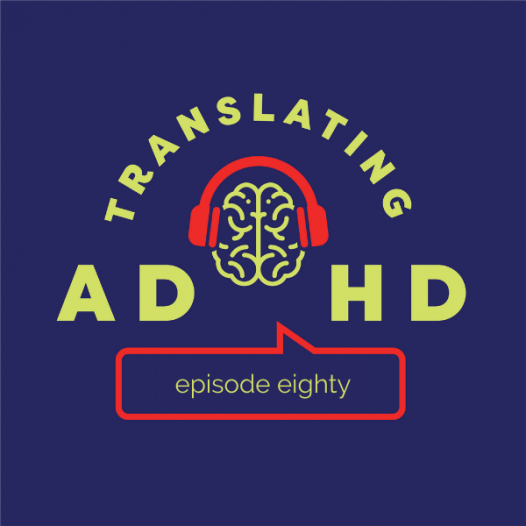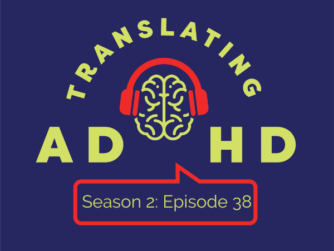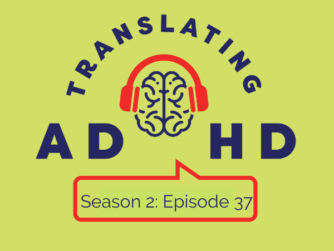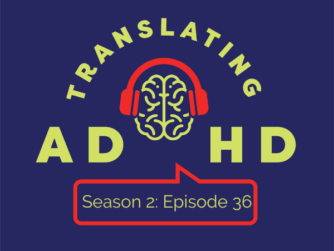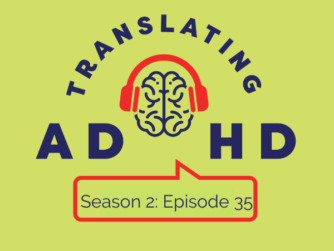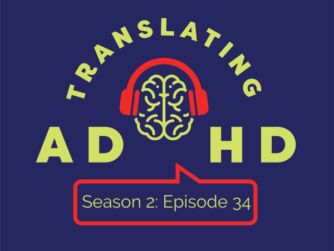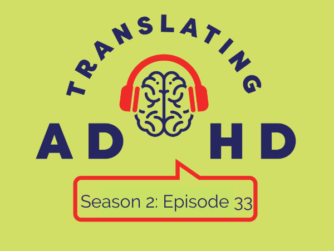As ADHD people, we pay most attention to the the things that generate the biggest signals. This week on the Translating ADHD podcast, Cam and Shelly discuss how big positive signals can be as disruptive here as big negative signals.
We discuss how listeners can build awareness around big positive signals, including our tendencies as ADHD people to use positive signals to avoid negative ones and to hyperfocus on positive signals to the detriment of other important but more subtle signals.
Episode links + resources:
For more of the Translating ADHD podcast:
- Episode Transcripts: visit TranslatingADHD.com and click on the episode
- Follow us on Twitter: @TranslatingADHD
- Visit the Website: TranslatingADHD.com
Episode Transcript:
Shelly: [00:00:00] Hi, I’m Shelly. (And I’m Cam). And this is the Translating ADHD podcast. Before we get started today, we have an exciting announcement. We are launching our second group coaching effort. The focus of this group is navigating the lunch counter. This group is for you if you want to do your own understand, own, and translate work with Cam and I, which includes better understanding your own specific ADHD dilemmas and shedding light on your next steps in this process of change.
This group begins Wednesday, June 23rd at 8:30 PM. Eastern. To inquire about joining the group, visit the website, translatingadhd.com, click on the group coaching link at the top of the page and fill out the form on that page. One of us will follow up when we start to form the group. Cam and I form our groups carefully so that everyone in the room can form a bond around the shared topic of navigating the lunch counter. Our coaching groups have this wonderful atmosphere of lightness and support, and we are so excited to bring this next effort to our listeners.
For the past few weeks, we’ve been focusing on big negative signals. This week, we’re going to flip the script and we’re going to focus on big positive signals.
Now I know what you all are thinking. Ah, okay. What a relief we’re going to get to the good stuff, but positive signals can get in the way just as much as negative signals can. And that’s kind of the tricky thing about ADHD. So let’s start by talking about the big brain manifestation. And Cam, I know you’re a big brain but I’m going to do my best to articulate what you’ve articulated over and over again on this show.
So Cam’s big idea generator. He gets an idea. He gets really excited about it. Digs in,, and it’s a big positive signal. Until it’s not. Until you hit that roadblock, or that stumbling block. Or that place where it gets hard. Or until another idea comes along and replaces the existing idea as the big positive signal.
So for big brainers, the manifestation is often chasing the next big thing the next big idea, but not reaching completion, not getting traction. So Cam tell us what the fast brain manifestation here looks like.
Cam: [00:02:40] You’re talking over there and I’m just going back to my experience of the big brain and the, and the idea generator. And I’m just like, Oh yeah. And it doesn’t just fall into work. We put out on the Discord of some ideas of some of our members. What’s your experience with big positive signals. I love what you just said there it’s like they’re big and positive until they’re not. So anything new, a new relationship.
For me, new relationships, it was everything, everything melted away. And it became that until it didn’t become that. Commitment, what? Continuing, what? This is hard. It’s that cut and run guy. So new love, new things, new opportunities, those big signals that happen. There’s the big brain.
The fast brain is something I see a lot with a lot of my leader clients, and they will often sort of come with this idea of, Hey, do you have the code for this? Do you have the code to make this more available? They’re a little bit disappointed when we start talking about that, because that’s that positive signal. What does it create? It creates that hyper-focus it basically he solves our ADHD dilemma, but just in the moment.
It gives us what we’re looking for. It’s intoxicating. It’s fun. It’s interesting. But is it sustainable? So for me and my clients who are fast brainers, it’s this okay, here’s this thing. This opportunity, the deal. And this is the deal. Like no other deal. And focus on that and go for it. So it’s this destination and to pounce on it, these goal oriented individuals who use the positive signal in a way to push forward and activate, get things done.
But, you know, look at the wake behind them. There was a cartoon of this child, like walking along. In front of them it’s like spring time and behind them, it was like burned and singed, kind of the wake that they create. And I’m like, Oh my goodness. If we could only see that this is that manifestation, this is below the lunch counter.
We will go and we will strive for something, but at what cost, and I see this actually impacting relationships in a tremendous way. Is where the spouse is not feeling connected, feeling left behind. And then the person with ADHD is like, why won’t you keep up with me? And my hyper fast brain. So the fast brainer will often build almost like a religion or cathedral around this idea of the positive signal.
Shelly, I got to say, there’s actually some people out there who call themselves ADHD coaches and are pitching this stuff. They talk about dopamine state and it’s just a gift. And it’s only a gift. It’s my superpower. And that’s it. That’s the interpretation. People, that’s not coaching. That is a program that people are pitching to you and selling. It’s a program, but it’s not coaching because it’s not a partnership and it’s not built for the long haul in the sense of what’s the bigger thing you want to build and sustain. That it’s about these big signals, negative and positive, but also those nuanced signals building relationships, building the business or the life that fits for you.
Shelly: [00:06:15] Cam, I think it might be helpful, talking about positive signals, to bring back DAM. So for those who might not remember, DAM is distracting behavior, avoiding behavior, and missing behavior or missing mechanisms. So D A M.
Cam: [00:06:35] Yeah. And part of that whole DAM model is sort of the setup that those missing behaviors are tucked down at the bottom. They’re buried. So we often have to get our shovel out on the surface what we see and what we experience are the distracting behaviors. Below that as we uncover and get past the distracting or the avoiding behaviors. And way below that are those missing and Oh, nuanced behaviors that are not necessarily going to respond to a big signal.
But those missing behaviors are tucked in underneath there. So I just wanted to throw that in of this hierarchy of D on the top. And that’s where we typically kind of start with this process.
Shelly: [00:07:19] So Cam I’d like to break down DAM using a client example, and this is a client that listeners have already met. Is that all right?
Cam: [00:07:28] Yes.
Shelly: [00:07:29] This client has a lot of hobbies and a lot of hobbies that he really enjoys. They bring him fulfillment. They are part of his self-care. They are important and foundational hobbies. Okay?
But when we started working together, there were several issues around hobbies. The first was pure distractability. So in addition to being into his hobbies, we talked about this client before he likes to talk about his hobbies with like-minded people.
So this is when he would go out to relevant internet forums and participate in conversations. And his articulation of what was happening at the time was that it would start very intentional. I want to check on this conversation that I participated in, or I want to share this thing that I’ve done and start a conversation, but where it ended was this mindless scrolling place.
And we all know that place, the place where you’re not even looking at the screen anymore or reading or registering, you’re just scrolling. He called it, the scatterbrainstate. He had no idea how he got there. How does this intentional behavior turn into scatterbrain state? So that’s where he was seeing the D of distracting behavior.
As we continued to work together, we started to notice some things in A. He definitely had some major projects at work that he was putting off, that were painful to make entry on. He was also taking a class for a certification that was self study and basically designed in the most ADHD unfriendly way possible.
So there was avoiding behavior there. We also noticed lack of completion. For as much as he liked to talk about his hobbies and engage with his hobbies he had a couple of projects that were sitting around that were very important to him that had not reached a completion state.
Cam: [00:09:41] I love that you’re bringing up completion because that’s that missing behavior that we often are not paying attention to. That big signal. That big positive signal is so powerful. We get pulled into that, the energy, and then the beating ourselves up for like, Oh, I wasted so much time in there. Why, why, why is that? And getting to this place of that avoidance is in part because of this inability to activate for task, break into the activity, and get a meaningful completion.
This goes back to meaningful, worthwhile completions in your day on the stuff that really matters.
Shelly: [00:10:26] Yeah. So our work became twofold and it was really cool to see how this played out. First of all, we distinguished between the actual hobby and doing actions within the realm of the actual hobby and talking about the hobby.
Those are two separate things that previously lived in the same place in his mind, because talking about the hobby would get him the same dopamine spike that engaging with the hobby would give him without making any meaningful progress. So we distinguished that first.
And then a callback to the last time I talked about this client, we worked on changing the behavior around engaging in discussion. And that wasn’t to cut it out completely, but to put it in its right place to recognize that this is not a high value activity, it’s something that I enjoy, but I don’t enjoy it when I get to scatterbrain state. I don’t enjoy it when I feel like there are other priorities that I didn’t get to because I was participating in this activity.
So how can we put it in its right place? We did a couple of things. The first was he had a little object on his desk and I don’t even remember what it was, but it was something that made him laugh. And he decided to start picking that up when he would participate in internet conversations about his hobby as a reminder of his intention. As a reminder to stop before scatterbrain starts and that worked.
But then he came back to coaching and said, Hey, that worked, but this is still taking too much time in my day. With the obligations that I currently have with work and this class and this upcoming exam, I just don’t have the time to spend a couple of hours a day doing this.
So then he noticed if I don’t leave an open loop, meaning if I don’t start or participate in a conversation, if I just read, I can do it once, first thing in the morning, then stop. So again, distinguishing right now, there’s not time in his life for participating in conversations relative to the value of the task. That task is lower value than the other things that were on the plate. So it’s the thing that he wanted to take time from to give time to these other priorities.
Cam: [00:12:52] I want to go back to something you said, I think is so ADHD that it’s just worth underlying and I just want to point that out. Is that what you said earlier about the awareness state, the thinking about it and the engaging part that, that pop that aha moment. It’s very difficult for us to distinguish those two states. So in a way it’s sort of like, it feels like you’re getting a completion. It feels like you’re engaging. But it’s just the brain getting its needs met.
This comes back to our brains are here trying to get its needs met. It doesn’t care about your projects. It doesn’t care. It really just wants to have its corrected brain chemistry. It’s going to make it feel good. And so then we’re under this assumption that, Oh, I’m getting lots done. I’m being productive.
That was my 90s Shelly. That was my 90s. And that moment with my wife, like after that, I was like, I’m doing stuff here, hun. What? I’m? You’re in the laboratory. You know, it’s the lab, it’s things are happening. Nothing’s happened at Cam nothing’s happening. What?
Things are happening in that dopamine state for me. And the sense of things are happening when in fact going to this idea of what is completion, what is it? And our ability to have an impact and create real change out in the world. That was the reckoning moment for me of, Oh, I’m not really creating change. All the changes happening is just in my synapses.
Shelly: [00:14:39] Yeah. I’m glad you called that out because it is such a common pitfall for those of us with ADHD and one that this client didn’t recognize. So let’s talk about where he and I went from here. First of all, I want to recap where we are currently in the story. So the client first noticed and named the distracting behavior and in doing our work there, we also noticed the avoiding behavior. And by distinguishing discussions from actual work on hobbies, we were able to recognize that he was putting a lot of time and effort into something that was not giving him any benefit was not moving him forward in any way.
So we recalibrated and we made time for what matters, which included completion of a hobby project that had been going on for two or three years. It was something that he started something that he wanted to fix that just never got completed.
And when we started to look at that particular task, he didn’t know why it hadn’t been completed other than he was putting a lot of time into discussion and very little time into hobbies largely out of this avoidance place. So what else were we doing while we were cleaning up the avoidance stuff? We were talking about the work projects and we were making forward progress there. We were talking about the class and the upcoming exam and making forward progress there. And we were linking to a really cool positive outcome because he had a trip planned that was relevant to one of his hobbies with his friends that was right after this exam.
And so we were sort of working toward being able to enjoy that trip fully. And this is where I love Tim Urban’s dark playground. For those that don’t know who Tim Urban is he does the Wait, But Why blog, and I love his articles on procrastination because I think they’re great metaphors. And one of the metaphors he used, this is the dark playground.
When we’re avoiding, we tend to turn to cheap dopamine hits. So what we don’t turn to is the hobby that matters. What my client wasn’t turning to is reaching completion on fixing that item that had been sitting around for two or three years. What he was turning toward was discussion was those cheap, easy fixes.
And that’s what we do when we’re in avoidance. And we tell ourselves it’s fun and enjoyable, but in the back of our brain, we know we’re avoiding. And that’s why it’s the dark playground. It’s not a happy place to be. You know, for some of you, this could look like endless Facebook scrolling or going down YouTube rabbit holes. It doesn’t matter what your manifestation is.
Cam: [00:17:22] Yeah day trading. Cryptocurrency.
Shelly: [00:17:25] And for some people there’s a fine line. Like with my client discussion can be a positive, to a point. And I will say for me, gaming falls into that category. I love to game. It’s a wonderful hobby for me, especially in COVID. Thank God I have a way to be social with people.
But I have to check in with myself if I’m gaming because I’m enjoying it, or if I’m gaming out of avoidance, because those are two very different places. One is very helpful. It’s part of my self-care it’s part of enjoying social time. And one is incredibly detrimental.
Cam: [00:18:01] I love the big brain story there and how it can manifest and DAM there in the sense of that avoiding what matters. And so looking at the fast brain, I think it’s an opportunity to really flip the script here. That DAM works, but it’s a little bit different here. That the focus is so much on the task that what happens is then it’s avoiding all the other stuff. It’s to the detriment of relationships and smart building of a business or an entity. That strategic view.
So here’s the high value and yet the positive signal creates for the fast brain is that it’s focused on this and nothing else, nothing else. In somehow that if I just focus on this somehow magically, everything else will kind of come along. So, these are sort of the high energy. The manifestation is a sort of supernova.
It was kind of fun at a party, you know, or fun for a day. But imagine that for weeks. Imagine that for months. And it’s almost like a manic state. The similarity here with the big brain that I’m seeing is the belief system that’s at play. That belief that, Hey, I’m getting points for just being engaged here.
That’s the damnedable thing about trying to get to missing behaviors because that distracting and avoiding behavior can be so convincing for me. It was so convincing that I was doing work. When in fact I wasn’t. What I said earlier about the fast brain manifestation. I’m not kidding there in the sense of building this religion, building this belief system around the positive signal so much so that I’m going to focus on this.
You help me find the elixir and I’ll just focus on this and getting this done and push this to an end point and that’ll take care of everything. It’ll take care of everything else. When in fact it doesn’t. So for the big brain, it’s sort of like the dilemma is more on the front end and activation and getting going and completion.
For the fast brain it’s more of, you know, getting going is not the problem. It’s the rocket and the rocket’s already going. So giving that rocket a way to maneuver in a way that’s not just about speed and getting to some destination. To start to think about what are we trying to do here? Is it just complete? What is the bigger opportunity? And the other thing is, this is why I like working with leaders is because they can start to outsource some of these important roles and responsibilities.
Shelly: [00:20:50] So the DAM tie in here. Cam was actually wondering off recording, how does DAM work for fast brainers? Because the distracting and avoiding isn’t happening on the destination.
There’s such a fixed hyper-focus there, but where it is happening, we figured out after we talked about it is in the burning path behind them, the things that they are not attending to. Because they’re purely distracted or because they’re avoiding it because it’s not in the realm of this thing that they’re fixated on.
So not attending to relationships, not attending to other important high value, things that matter, not attending to things where others are depending upon us to do something.
Cam: [00:21:37] And these things that are just not at that big, positive signal level, they’re more nuanced, but they’re also important. Leadership 101 is about having your vision, communicating your vision and implementing your vision. And this is again, someone who has you have your own business. You’re trying to create change in your day. This is basics for all of us. What’s my vision? Can I communicate it to someone else so they can be a support? And then that implementation and the rocket guy or the rocket person, the fast brainer, will often have a flash of a vision and forget the rest, forget the communicating aspect.
This like I’m going to go because again, that rule of use it or lose it. It was just like, Oh, I got an idea. Inspiration, go, and then wonder why no one’s catching up and be frustrated with why can’t they see what I see. So teaching that rocket a little bit of an extra maneuver there.
For the fast, brain in that rocket, that lights, and then just goes, how do you circle back over what matters? How do you circle back and pick up the stragglers? To communicate what matters? To enroll support in these finer details of completion? It just takes me back Shelly, to this idea, that completion is messy. As we go toward and get close to a completion point, it gets harder and harder because often we’re doing the fun stuff, the interesting stuff on the front end.
And then there’s certain attention to detail elements that we have to address or need to be addressed by something or some one. So it doesn’t have to be done by you listener whether you’re big brain or fast brain. Getting together and discussing.
The reason why Shelly had results with her client is because it was that engaging with discussing, moving in and out of this shame place or frustration place to this sort of safety place we talked about last week in the sense of the pool and moving to this, you know, I don’t like it, but I can handle it and I can learn from this place and make adjustments. To start to articulate and translate with others. Then you can find resources, you can find solutions, but it starts with getting out of our own limbic. The big signals, take us into the limbic. To come out, discuss, get strategic and developing some supports and accountability.
Shelly: [00:24:21] Exactly Cam. And that’s the tricky thing about positive signals is they can land us in exactly the same place as the negative signals. Either way we end up in the pool.
Cam: [00:24:33] I want to say one more thing. This is for the fast brainers who are listening to us at 1.5 speed. I come on I. What do you guys doin? And you’re taking all the fun away from me. Here’s the thing that I see is that often it’s, again, back to that supernova in that high energy, we’re often trying to play polo.
Have you ever been to a polo match people? It’s crazy. The field is enormous and we’re trying to play polo on a little league diamond. We need a bigger space to give that rocket ship space to maneuver. We’re hunters, but hunt with intention to determine where you hunting and why you hunting and to bring your tribe with you, who is going to process the hunt with you?
Cause it’s not just about hunting. It’s more than that. And how can it be more than that to consider that? I just wanted to bring that in at the end, Shelly.
Shelly: [00:25:32] Yeah. So I think that’s a good place for us to wrap for today. Listeners, your opportunity is to pay attention to those quote unquote positive signals, because what we’ve demonstrated today is they can be alluring and they can feel really good in the moment because they give us that dopamine hit or that sense of achievement.
But when you step back and really evaluate what’s going on, you get a very different picture. So just like everything else we do on the show, the first opportunity is to be aware of the behavior when it is happening. And then from there you can get curious. So, if you like what we’re doing here on the show, there are a couple of big ways you can help us out.
The first is to leave a review wherever you listen. The next is to financially support the show by becoming a patron. Visit the website, translatingadhd.com. Click on the Patreon link in the upper right-hand corner. And for five bucks a month, not only are you supporting the running of the show. You also gain access to our Discord community, where our listeners are working together to do their own understand, own and translate work.
So until next week, I’m Shelly. (And I’m Cam). And this was the Translating ADHD podcast. Thanks for listening.

